24 Jan , 2025 By : Debdeep Gupta

The Nifty 50 extended gains amid range-bound trade, rising 0.2 percent on January 23, but has still been broadly moving in the range of 23,000-23,400 since last week. The overall sentiment remains bearish, with a continuation of lower tops and lower bottoms on the daily charts, and the index is trading below all key moving averages. Hence, the consolidation may persist until the index gives a strong close above 23,400, with support at 23,000. A break of this support could drag it down toward the 22,800 level, according to experts.
Here are 15 data points we have collated to help you spot profitable trades:
1) Key Levels For The Nifty 50 (23,205)
Resistance based on pivot points: 23,258, 23,300, and 23,369
Support based on pivot points: 23,120, 23,078, and 23,009
Special Formation: The Nifty 50 formed a bullish candlestick pattern with a minor upper shadow on the daily charts, still holding onto the downward-sloping support trendline. However, it remained below all key moving averages (10, 20, 50, 100, and 200-day EMAs), with a negative bias in the momentum indicators, signaling a weak bias.
2) Key Levels For The Bank Nifty (48,589)
Resistance based on pivot points: 48,811, 48,905, and 49,058
Support based on pivot points: 48,506, 48,411, and 48,259
Resistance based on Fibonacci retracement: 49,453, 50,406
Support based on Fibonacci retracement: 47,878, 46,078
Special Formation: The Bank Nifty underperformed the benchmark Nifty 50, falling 0.3 percent, and formed a bearish candlestick pattern on the daily timeframe. It is sustaining below all key moving averages and in the lower band of the Bollinger Bands, signaling weakness. The momentum indicators also show a negative trend.
3) Nifty Call Options Data
According to the monthly options data, the 24,000 strike holds the maximum Call open interest (with 90.58 lakh contracts). This level can act as a key resistance for the Nifty in the short term. It was followed by the 23,800 strike (54.01 lakh contracts) and the 23,500 strike (52.7 lakh contracts).
Maximum Call writing was observed at the 24,000 strike, which saw an addition of 16.88 lakh contracts, followed by the 23,800 and 23,600 strikes, which added 14.02 lakh and 11.08 lakh contracts, respectively. The maximum Call unwinding was seen at the 23,100 strike which shed 2.51 lakh contracts, followed by the 23,000 and 22,500 strikes, which shed 1.79 lakh and 30,775 contracts, respectively.
4) Nifty Put Options Data
On the Put side, the maximum Put open interest was seen at the 23,000 strike (with 67.96 lakh contracts), which can act as a key support level for the Nifty. It was followed by the 22,500 strike (51.37 lakh contracts) and the 23,200 strike (40.41 lakh contracts).
The maximum Put writing was placed at the 23,000 strike, which saw an addition of 13.45 lakh contracts, followed by the 23,200 and 22,300 strikes, which added 13.36 lakh and 11.38 lakh contracts, respectively. The maximum Put unwinding was seen at the 24,000 strike, which shed 40,550 contracts, followed by the 24,250 and 23,950 strikes, which shed 1,550 and 1,150 contracts, respectively.
5) Bank Nifty Call Options Data
According to the monthly options data, the 49,500 strike holds the maximum Call open interest, with 25.88 lakh contracts. This can act as a key resistance level for the index in the short term. It was followed by the 50,000 strike (23.77 lakh contracts) and the 49,000 strike (16.81 lakh contracts).
Maximum Call writing was visible at the 49,500 strike (with the addition of 10.78 lakh contracts), followed by the 48,700 strike (2.82 lakh contracts) and the 50,500 strike (1.85 lakh contracts). The maximum Call unwinding was seen at the 47,000 strike, which shed 44,430 contracts, followed by the 48,000 and 47,500 strikes, which shed 21,930 and 3,075 contracts, respectively.
6) Bank Nifty Put Options Data
On the Put side, the maximum Put open interest was seen at the 47,500 strike (with 17.54 lakh contracts), which can act as a key support level for the index. This was followed by the 47,000 strike (15.36 lakh contracts) and the 48,000 strike (14.33 lakh contracts).
The maximum Put writing was observed at the 47,500 strike (which added 10.36 lakh contracts), followed by the 48,700 strike (1.54 lakh contracts) and the 47,000 strike (74,235 contracts). The maximum Put unwinding was seen at the 48,800 strike, which shed 25,425 contracts, followed by the 48,400 and 48,100 strikes which shed 23,790 and 18,450 contracts, respectively.
7) Funds Flow (Rs crore)
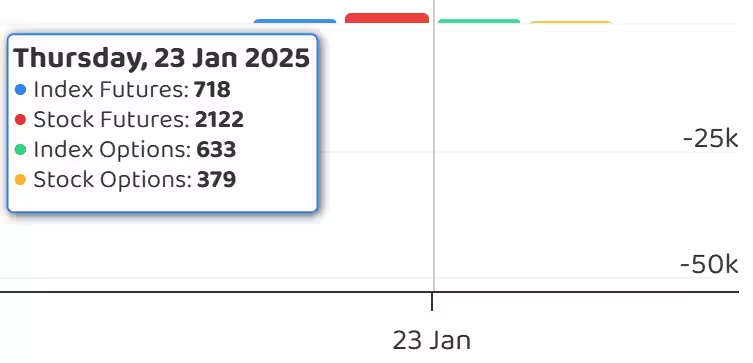
8) Put-Call Ratio
The Nifty Put-Call ratio (PCR), which indicates the mood of the market, rose to 0.95 on January 23, from 0.88 level in the previous session.
The increasing PCR, or being higher than 0.7 or surpassing 1, means traders are selling more Put options than Call options, which generally indicates the firming up of a bullish sentiment in the market. If the ratio falls below 0.7 or moves towards 0.5, then it indicates selling in Calls is higher than selling in Puts, reflecting a bearish mood in the market.
9) India VIX
The volatility index, India VIX, which measures expected market volatility, continued its downward move for another session, falling 0.46 percent to 16.70. It remains in the higher zone, signaling caution for bulls.
10) Long Build-up (89 Stocks)
A long build-up was seen in 89 stocks. An increase in open interest (OI) and price indicates a build-up of long positions.
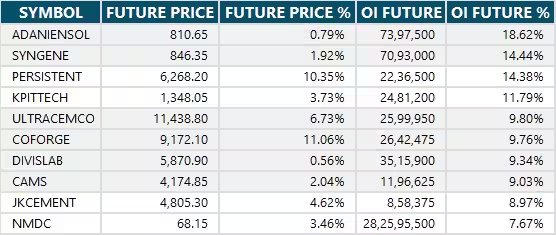
11) Long Unwinding (15 Stocks)
15 stocks saw a decline in open interest (OI) along with a fall in price, indicating long unwinding.
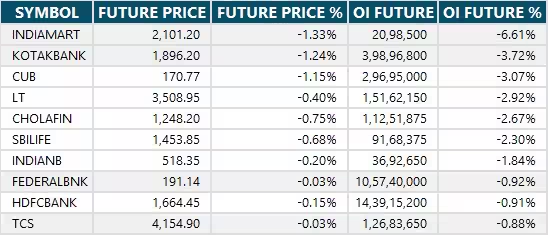
12) Short Build-up (31 Stocks)
31 stocks saw an increase in OI along with a fall in price, indicating a build-up of short positions.
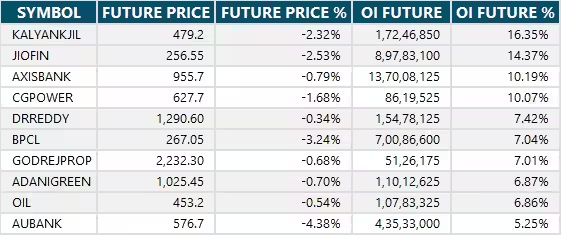
13) Short-Covering (92 Stocks)
92 stocks saw short-covering, meaning a decrease in OI, along with a price increase.
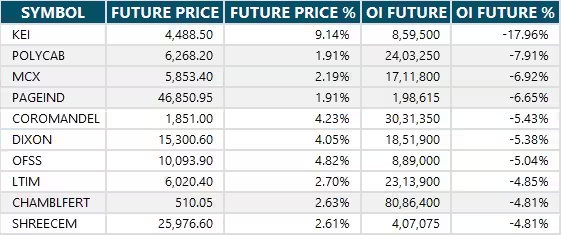
14) High Delivery Trades
Here are the stocks that saw a high share of delivery trades. A high share of delivery reflects investing (as opposed to trading) interest in a stock.

15) Stocks Under F&O Ban
Securities banned under the F&O segment include companies where derivative contracts cross 95 percent of the market-wide position limit.
Stocks added to F&O ban: Nil
Stocks retained in F&O ban: Aditya Birla Fashion & Retail, Bandhan Bank, Can Fin Homes, Dixon Technologies, IndiaMART InterMESH, L&T Finance, Manappuram Finance, Mahanagar Gas, Punjab National Bank
Stocks removed from F&O ban: RBL Bank
0 Comment